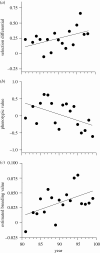Evolution of quantitative traits in the wild: mind the ecology
- PMID: 20643732
- PMCID: PMC2935108
- DOI: 10.1098/rstb.2010.0108
Evolution of quantitative traits in the wild: mind the ecology
Abstract
Recent advances in the quantitative genetics of traits in wild animal populations have created new interest in whether natural selection, and genetic response to it, can be detected within long-term ecological studies. However, such studies have re-emphasized the fact that ecological heterogeneity can confound our ability to infer selection on genetic variation and detect a population's response to selection by conventional quantitative genetics approaches. Here, I highlight three manifestations of this issue: counter gradient variation, environmentally induced covariance between traits and the correlated effects of a fluctuating environment. These effects are symptomatic of the oversimplifications and strong assumptions of the breeder's equation when it is applied to natural populations. In addition, methods to assay genetic change in quantitative traits have overestimated the precision with which change can be measured. In the future, a more conservative approach to inferring quantitative genetic response to selection, or genomic approaches allowing the estimation of selection intensity and responses to selection at known quantitative trait loci, will provide a more precise view of evolution in ecological time.
Figures



Similar articles
-
The danger of applying the breeder's equation in observational studies of natural populations.J Evol Biol. 2010 Nov;23(11):2277-88. doi: 10.1111/j.1420-9101.2010.02084.x. Epub 2010 Sep 9. J Evol Biol. 2010. PMID: 20831731
-
The Price equation as a bridge between animal breeding and evolutionary biology.Philos Trans R Soc Lond B Biol Sci. 2020 Apr 27;375(1797):20190360. doi: 10.1098/rstb.2019.0360. Epub 2020 Mar 9. Philos Trans R Soc Lond B Biol Sci. 2020. PMID: 32146890 Free PMC article.
-
Evolutionary potential of morphological traits across different life-history stages.J Evol Biol. 2017 Mar;30(3):616-626. doi: 10.1111/jeb.13031. Epub 2017 Jan 6. J Evol Biol. 2017. PMID: 28000316
-
A centennial celebration for quantitative genetics.Evolution. 2007 May;61(5):1017-32. doi: 10.1111/j.1558-5646.2007.00100.x. Evolution. 2007. PMID: 17492957 Review.
-
Why are estimates of the strength and direction of natural selection from wild populations not congruent with observed rates of phenotypic change?Bioessays. 2016 Sep;38(9):927-34. doi: 10.1002/bies.201600017. Epub 2016 Jul 12. Bioessays. 2016. PMID: 27401716 Review.
Cited by
-
Genetic contributions to dental dimensions in brown-mantled tamarins (Saguinus fuscicollis) and rhesus macaques (Macaca mulatta).Am J Phys Anthropol. 2019 Feb;168(2):292-302. doi: 10.1002/ajpa.23744. Epub 2018 Dec 3. Am J Phys Anthropol. 2019. PMID: 30508220 Free PMC article.
-
Spatial and Temporal Variation in Selection of Genes Associated with Pearl Millet Varietal Quantitative Traits In situ.Front Genet. 2016 Jul 26;7:130. doi: 10.3389/fgene.2016.00130. eCollection 2016. Front Genet. 2016. PMID: 27507986 Free PMC article.
-
Understanding the biology of species' ranges: when and how does evolution change the rules of ecological engagement?Philos Trans R Soc Lond B Biol Sci. 2022 Apr 11;377(1848):20210027. doi: 10.1098/rstb.2021.0027. Epub 2022 Feb 21. Philos Trans R Soc Lond B Biol Sci. 2022. PMID: 35184590 Free PMC article.
-
How migratory populations become resident.Proc Biol Sci. 2020 Mar 25;287(1923):20193011. doi: 10.1098/rspb.2019.3011. Epub 2020 Mar 18. Proc Biol Sci. 2020. PMID: 32183624 Free PMC article.
-
The timing of GIGANTEA expression during day/night cycles varies with the geographical origin of Arabidopsis accessions.Plant Signal Behav. 2017 Jul 3;12(7):e1342026. doi: 10.1080/15592324.2017.1342026. Epub 2017 Jun 23. Plant Signal Behav. 2017. PMID: 28644109 Free PMC article.
References
-
- Abzhanov A., Protas M., Grant B. R., Grant P. R., Tabin C. J.2004Bmp4 and morphological variation of beaks in Darwin's finches. Science 305, 1462–1465 (doi:10.1126/science.1098095) - DOI - PubMed
-
- Abzhanov A., Kuo W. P., Hartmann C., Grant B. R., Grant P. R., Tabin C. J.2006The calmodulin pathway and evolution of elongated beak morphology in Darwin's finches. Nature 442, 563–567 (doi:10.1038/nature04843) - DOI - PubMed
-
- Albon S. D., Cluttonbrock T. H., Guinness F. E.1987Early development and population-dynamics in red deer. 2. Density-independent effects and cohort variation. J. Anim. Ecol. 56, 69–81
-
- Charmantier A., Garant D.2005Environmental quality and evolutionary potential: lessons from wild populations. Proc. R. Soc. B 272, 1415–1425 (doi:10.1098/rspb.2005.3117) - DOI - PMC - PubMed
-
- Charmantier A., Perrins C., McCleery R. H., Sheldon B. C.2006Evolutionary response to selection on clutch size in a long-term study of the mute swan. Am. Nat. 167, 453–465 - PubMed
MeSH terms
LinkOut - more resources
Full Text Sources

